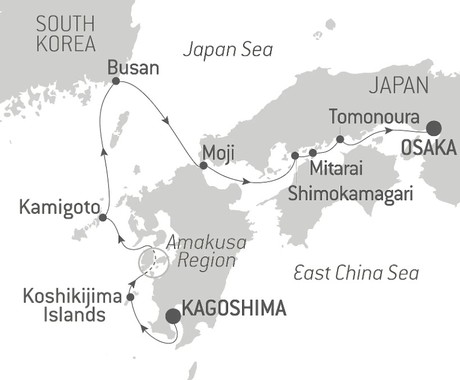Japan, Natural Archipelago and Secular Heritage Luxury Cruise
With this itinerary, PONANT is inviting you aboard Le Jacques-Cartier for a unique expedition cruise between Kagoshima and Osaka. A magical 9-day trip to discover some of the natural gems and ancestral heritage of western Kyushu, as well as picturesque villages in the Seto Inland Sea, the theatre of many battles and historic events that have shaped its myth and grandeur over time and with the ebb and flow of the tides.
After setting sail from Kagoshima, a bustling city nestling between ancient forests and majestic volcanoes, Le Jacques-Cartier will travel westward to reach the fascinating Koshikijima Islands. Aboard one of our Zodiacs, you will be fascinated by the raw and authentic beauty of the monumental cliffs and huge rock formations dating back to the Cretaceous periodnearly 80 million years ago.
Between the Yatsushiro and Ariake seas, off the coast of Nagasaki, succumb to the charms of the island region of Amakusa, once the refuge of Christians fleeing the ban on Catholicism in the 17th century during the Edo period. Christian heritage can also be found further north, in the Goto Islands, on Kamigoto Island. Here, each small town bears traces of this influence that is still very much present, as evidenced by the many religious buildings dotting Kamigoto.
Then you will sail to South Korea, a small peninsula that juts out into the Sea of Japan, and discover Busan, South Korea’s second city. This richly contrasting city will unveil its port and the old district of Chalgachi.
Back in Japan, you will set out to discover Moji, on the northern tip of the island of Kyushu. In the past a strategic site for maritime trade with China, this stunning city of picturesque little streets will enthral you with its preserved architectural heritage evoking the traditional Japan of the Meiji era and the end of the 19th century. From the top of the Mojiko Retro Observation Room, you will be able to enjoy an exceptional panorama, a poetic combination of shinto sanctuaries and captivating maritime landscapes.
After a trip aboard one of our Zodiac dinghies, in the pretty fishing villages of Shimokamagari and Mitarai, you will arrive in Tomonoura, known for its gentle way of life and its craggy landscapes that inspired the director Hayao Miyazaki for the landscapes of Ponyo.
Finally, for a grand finale, your journey will end in Osaka, your disembarkation port.
The seaside city of Kagoshima, at the south of Kyushu Island, ᅠis best known for Sakurajima, an active volcano that faces Kinko Bay. A visit to this busy metropolis will remind you just how much the volcano is part of the inhabitants' everyday life: in the wake of the almost daily eruptions, a delicate layer of ash settles on everything. The top of a buried torii (traditional Japanese gate) measuring three metres that was 'swallowed up' by a giant lava flow in 1914 can still be seen. The power of nature will send a shiver down your spine.
Off the western coastlines of Kagoshima Prefecture, the rocky and green islets called the Koshikijima Islands rise like a mirage from the East China Sea. Aboard our Zodiac dinghies, you will reach the three islands that make up the archipelago: Kamikoshikishima, Nakakoshikishima and Shimokoshikishima. You will be captivated by the raw and authentic beauty of this environment, featuring monumental cliffs and huge rock formations that date back to the Cretaceous periodor nearly 80 million years. During hikes, you will be lucky enough to discover these unique and striking landscapes. An interlude where time may stand still.
Facing the mythical island of Kyushu, between the Yatsushiro and Ariake seas, the island region of Amakusa both surprises and captivates. Composed of some one hundred verdant islets surrounded by stunning seabeds, the Japanese archipelago was once a refuge for many Christians fleeing the ban on Catholicism in the 17th century during the Edo period. Christian heritage can be found in every village in the region. In Sakitsu, a charming fishing port, immerse yourself in this Christian heritage, particularly when you visit the emblematic church listed as a UNESCO World Heritage Site.
Representing a little-known, distant, almost abandoned Japan at the western tip of the island of Kyushu, to the west of the China Sea, Kamigoto Island recounts the unexpected history of the Empire of the Rising Sun. A refuge for Christians fleeing the prohibition of practising their Catholic faith in the 17th century under the Edo era, each village bears traces of this influence that is still very much present, as evidenced by the many religious buildings dotting the island. Famous for its lush and preserved nature, featuring tropical forests and jagged shores, Kamigoto boasts natural treasures such as Hamaguri beach, an aquatic paradise of fine sand surrounded by turquoise waters and encircled by bewitching green peaks.
With around four million inhabitants, Busan is the second largest metropolis on South Korea, after Seoul. This dynamic harbour city, located in the south-east, surrounded by the warm waters of the Sea of Japan, benefits from a mild, pleasant climate. You’ll find delightful simply to stroll around the lively streets and explore the city’s outstanding cultural heritage of art galleries, museums, and Buddhist sites, such as the Haedong Yonggungsa temple, which elegantly sits on the waterfront. Rich too in magnificent beaches and superlative natural landscapes, Busan’s peaceful atmosphere will win you over, as will its inhabitants, whom you’ll have the pleasure of meeting.
At the mouth of the Kanmon Straits lies Mojiko, the northernmost port of Kyushu, one of Japan’s four main islands. For many years, Mojiko was the gateway to the island. Today, the old boats are gone, but as you stroll around the picturesque streets you will discover a well-preserved architectural heritage that evokes traditional Japan from the first Meiji era of the late 19th century. From the heights of the Mojiko Retro Observation Room, you can enjoy the amazing views that take in the Shinto shrine and coastal landscape like a postcard of the Land of the Rising Sun. Sailing in the Kanmon Straits, between the Japanese islands of Honshu and Kyushu, promises an unforgettable experience. During the crossing of this emblematic maritime passage linking the Sea of Japan to the Seto Inland Sea, fall under the spell of this traditional Japan, with its charming picturesque fishing ports and its shrines built in the heart of enchanting nature, between verdant hilly peaks and captivating granite cliffs.
The island of Shimokamagari stretches into the heart of the Seto Inland Sea, off the coast of the town of Kure, in the Hiroshima prefecture. A historical city during the feudal period, the island was the theatre of major diplomatic missions for the future and the Empire’s trade relationships, notably with repeated visits from mainly Korean, but also Chinese and Dutch, emissaries. Registered since 2017 on the UNESCO Memory of the World Programme, documentary heritage of these encounters is conserved in the Shotoen Garden, one of the emblems of this lush islet. A magnificent Japanese garden with perfectly kept grounds, interspersed with raked pebbles and surrounded with majestic trees, it is home to a Rantokaku Museum complex, consisting of four exhibition rooms tracing the island’s naval history. A charming fishing village nestling in the east of Osaki Shimojima Island, on the edge of the Seto Inland Sea, Mitarai is appreciated for its traditional charm and authentic character. A trip back in time to the Edo Period, where the hustle and bustle of modern cities is replaced by the gentle sound of fishing boats. Thanks to its 19th century wooden dwellings lining the small, narrow streets, its great causeway, its centuries-old sanctuaries and its gangi stairs, a stone structure giving on to the sea, the old town was classed as a Preservation District by the Japanese state in 1994. Between the islands of Honshu and Shikoku, in the very heart of the emblematic Seto Inland Sea, the Kurushima Strait will unveil a traditional and picturesque Japan. This 4-kilometre (2.5-mile) maritime route, with swift currents, will give you the opportunity to discover certain great feats of engineering, such as the mythical Kurushima Kaikyō Bridge. This colossal construction is the first triple bridge and the longest set of suspension bridges in the world, with a total length of 4,105 metres (almost 13,500 feet) In the footsteps of the Japanese traders from the middle of the 18th century, fall under the spell of the charming picturesque fishing ports that line this historic maritime route.
Anchored to the south-eastern end of the Nunakama Peninsula, facing the calm and clear waters of the Seto Inland Sea, Tomonoura is a destination particularly appreciated for its authentic and old-fashioned atmosphere that gives it an incomparable charm. In the past used as a port where boats would moor while waiting for a favourable wind, the charming and picturesque village now serves to inspire many filmmakers and artists. With good reason, since its craggy landscapes, its cherry trees in blossom, its gentle way of life, its traditional wooden houses and its port, preserved since the Edo era, notably enabled the artist Hayao Miyazaki to make the animated film Ponyo.
Like its big sister Tokyo, Osaka is the product of ancestral traditions and amazing technological innovations. And despite its size, its location on the Pacific Ocean give it a sense of serenity. The main historic landmark is the 16th century Osaka Castle, which stands proud in the midst of majestic skyscrapers. The lively streets of Dotomburi and the bizarre Shinsekai district attract thousands of locals and visitors. A multitude of restaurants offer menus full of regional specialities: takoyaki, made with octopus, and other succulent dishes such as kushikatsu kebabs.
Itineraries are subject to change.
|
Book now |
Kagoshima to Kobe Voyage
Grand Deluxe Suite
Owner’s suite
DeLuxe Stateroom
Privilege Suite
Prestige Suite - Deck 5
Prestige Stateroom - Deck 5
Superior Stateroom
Deluxe Suite
Prestige Stateroom - Deck 4
Prestige Stateroom - Deck 6
|
Book now |
Superior Stateroom
DeLuxe Stateroom
Prestige Stateroom - Deck 4
Prestige Stateroom - Deck 5
Prestige Stateroom - Deck 6
Deluxe Suite
Prestige Suite - Deck 5
Privilege Suite
Grand Deluxe Suite
Owner’s suite
|
Book now |
Superior Stateroom
DeLuxe Stateroom
Prestige Stateroom - Deck 4
Prestige Stateroom - Deck 5
Prestige Stateroom - Deck 6
Deluxe Suite
Prestige Suite - Deck 5
Privilege Suite
Grand Deluxe Suite
Owner’s suite
Additional charges:
Port Taxes and Fees: 590 AUD pp
Vessel Type: Luxury
Passenger Capacity: 92 cabins
Built: 2018/2019
Featuring innovative and environmentally-friendly equipment, elegantly designed staterooms, spacious suites with large windows, and lounge areas that open onto the outside, this new limited-capacity yacht boasting just 92 staterooms and suites will offer you a truly unique cruising experience.
As the sixth ship in a new series that remains true to the Ponant spirit, Le Jacques Cartier will embody the unique atmosphere that is the cruise line’s hallmark: a subtle blend of refinement, intimacy and comfort.
Aboard this ship that flies the French flag, you will experience the incomparable pleasure of an intimate cruise, with the possibility of exploring an ever-increasing range of destinations in an ethnic-chic ambiance with luxury service.
Experience a luxurious setting where the accent is on authenticity and passion for travel.
RESTAURANTS
As it is an essential part of French culture, gastronomy will naturally have pride of place aboard this new ship.
To the back of Deck 4, you will find a 260 m² panoramic restaurant which can accommodate all of our passengers in a single sitting. Designed differently to that on our other ships, this dining area, which opens onto the outside, will have a buffet of salads, desserts and cheeses at your disposal. Our discreet and attentive crew will provide table service for hot meals.
In a relaxed atmosphere, an outdoor grill on Deck 3 will serve grilled meats with a variety of salads and desserts.
PUBLIC AREAS
Le Jacques Cartier has many common areas that are designed and equipped to meet all of your needs while preserving the intimacy of each passenger.
A 140 m² reception area includes:
A reception/concierge desk,
An excursions desk,
The ship’s administrative services,
The sales office, manned by our Guest Relations Officer,
Our 50 m² boutique which sells clothing, jewellery, beauty products, postcards and various accessories,
Toilets accessible to passengers with reduced mobility.
A new hydraulic platform with adjustable height provides:
Easier boarding than on any other cruise ship,
Easier Zodiac embarkation and disembarkation for expeditions,
Easier access to the sea for swimming and practising various water sports such as kayaking or paddle-boarding.
A pool deck offering:
A pool with a panoramic view, equipped with a counter-current swimming system,
A pleasant solarium,
An outdoor bar and lounge with armchairs and sofas.
A 200 m² main lounge which can accommodate all of our passengers to share convivial moments and to host activities organised during the day or evening.
Lastly, a theatre that seats 188, equipped with:
The latest sound and lighting technology,
A LED wall as the stage backdrop, for the projection of high-resolution images and videos.


Special Offers
Up to 30% OFF! Prices online do not show the discounted rates. Terms and Conditions apply, special offer is subject to availability, please contact us for more details.
Inclusions
• Voyage on board in selected cabin category
• All meals while on board
• Non-alcoholic and Alcoholic beverages included (Excluding Premium Brands)
• Free wifi (Subject to coverage)
• Expedition cruises include excursions and zodiac cruises
• Some shore excursions are included, depending on the voyage destination
Exclusions
• Flights other than those mentioned in the itinerary
• Travel insurance
• Passport and visa costs if applicable
• Premium beverages package (Can be purchased on board)
• Optional Excursions where applicable
• Spa treatments on board
• Pre and post cruise accommodation unless otherwise stated
• Transfers unless specified
• Gratuities
Highlights
• A brand-new expedition cruise to discover the gems of western Kyushu and of the Seto Inland Sea, including natural wonders, Japanese culture and ancestral traditions, but also the country’s little-known Christian heritage.• Outings and shore visits in zodiac inflatables with a team of experienced naturalist guides.
• UNESCO sites: “the hidden Christian sites in the Nagasaki region”, in Sakitsu and Kamigoto, Yakushima Island.
• Brand-new ports of call in the Koshikijima Islands, on Kamigoto and in the island region of Amakusa.
• All-new crossings of the Kanmon Straits and the Kurushima Strait, emblematic passageways on the Kitamae maritime route.
• The discovery of Japan’s Christian history, a religion banned for three centuries during the Edo period.
• Sakitsu, a picturesque village of preachers and the only Christian site in Kumamoto Prefecture.
• Varied landscapes along the Seto Inland Sea, offering stunning contrasts between land and sea.
• Discover the history, cultures, and the incredible diversity of the flora and fauna thanks to our team of naturalist guides with expertise in this destination.
Our Associates Include







